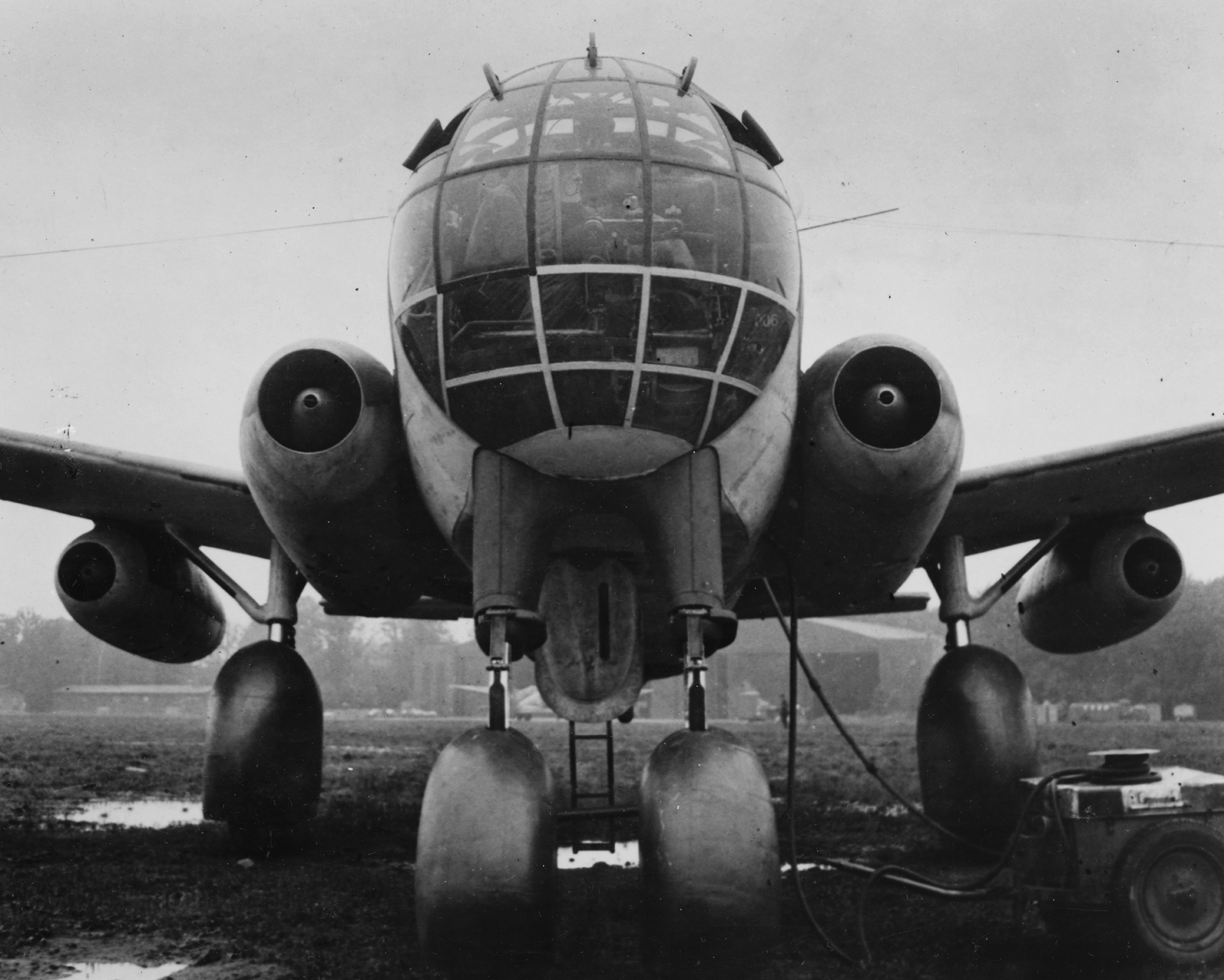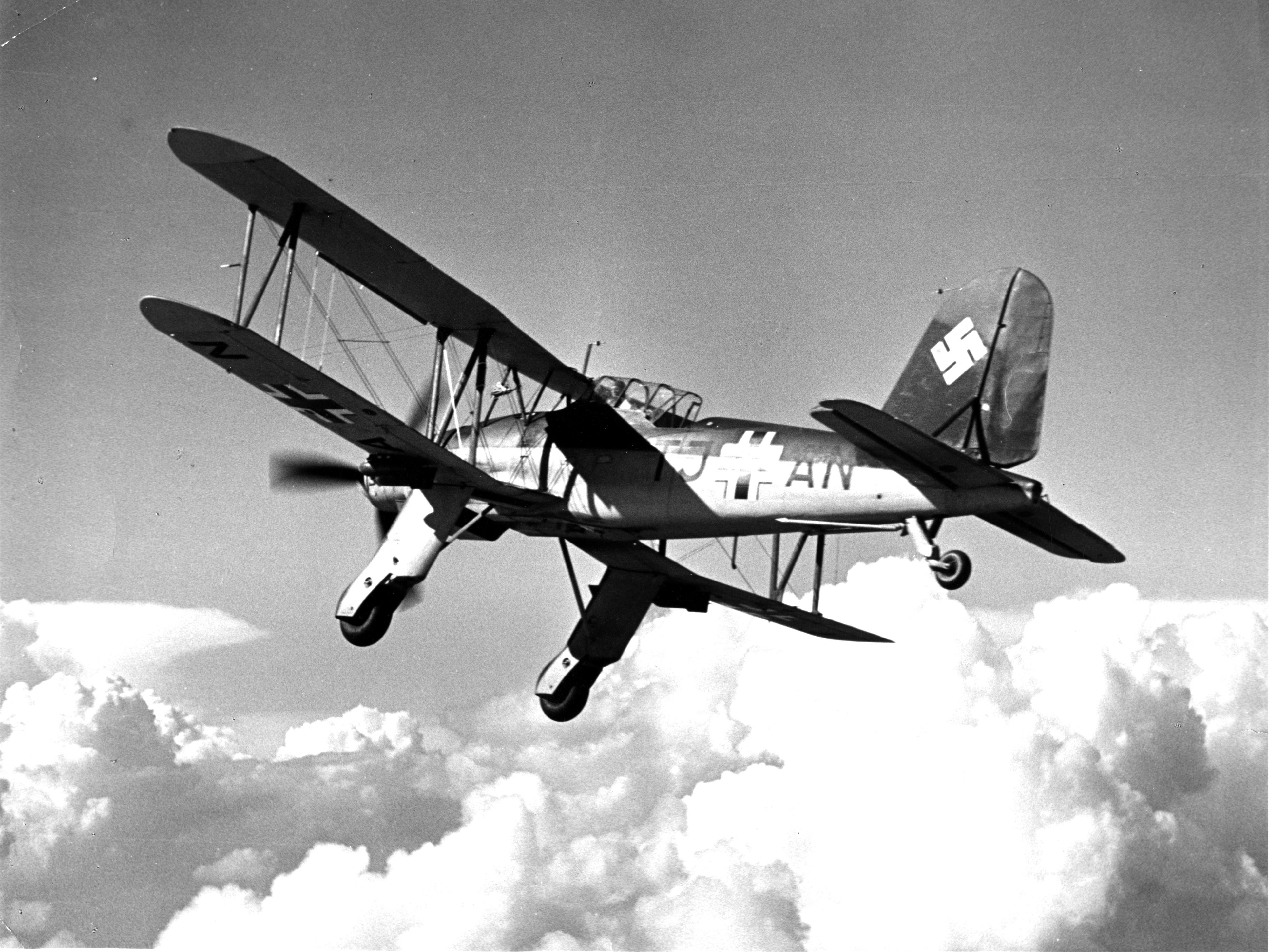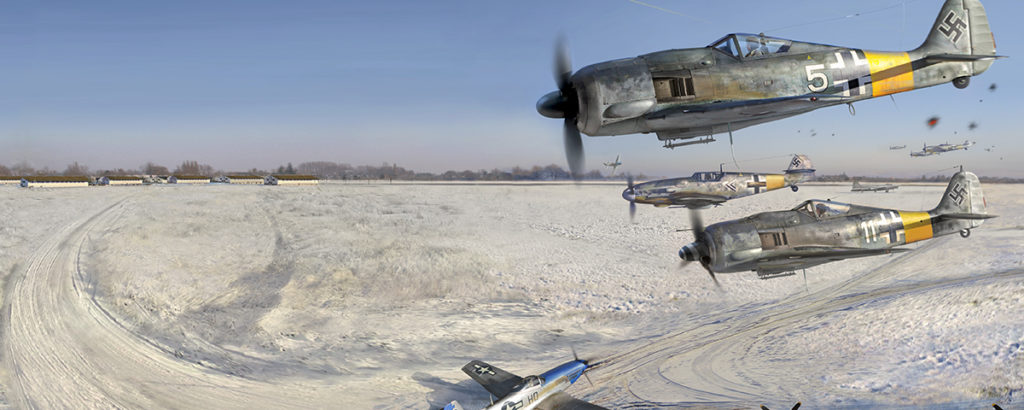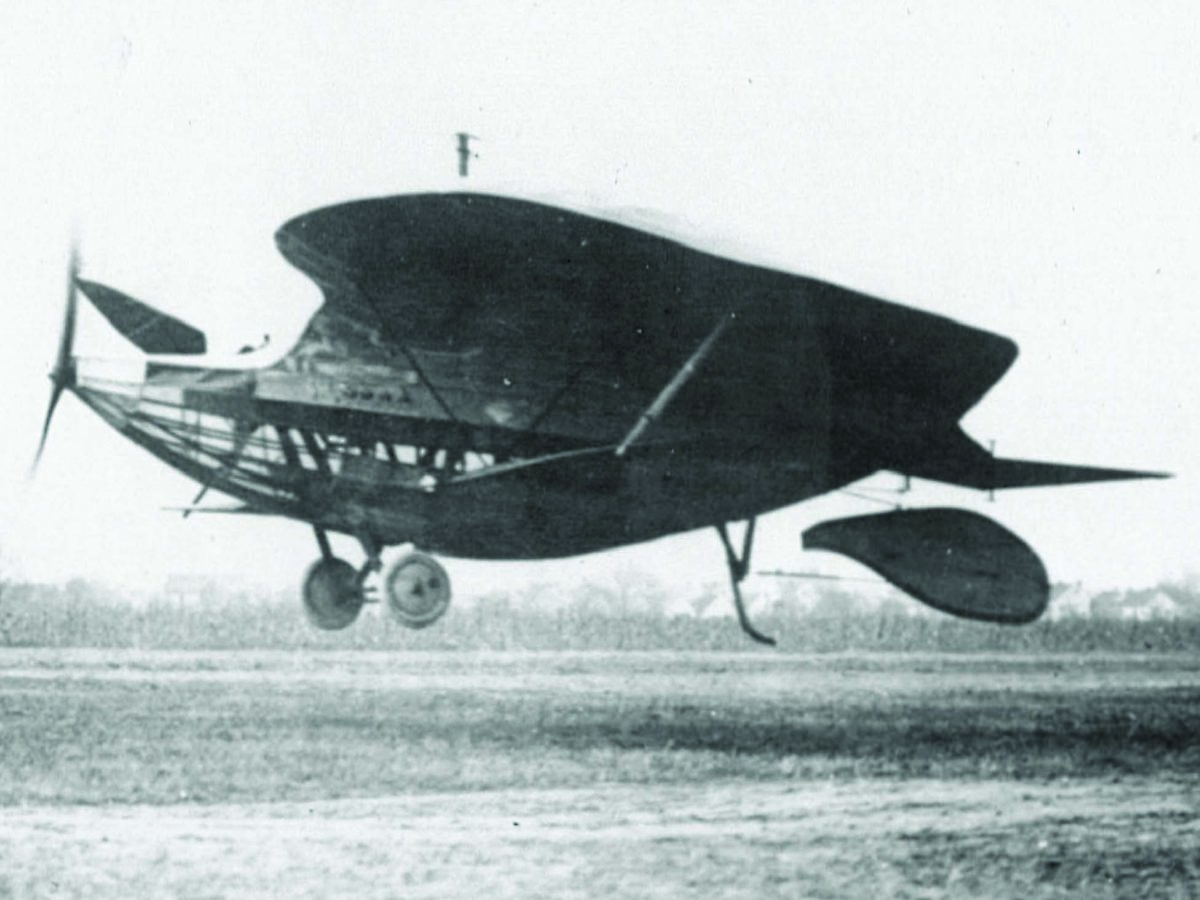One of the most unusual aircraft to emerge from German drawing boards in the latter stages of World War II was the Junkers Ju-287V1, a flying test-bed for a jet-powered medium bomber that could outrun the fastest Allied fighters. Early in 1943, that development challenge fell to the firm of Junkers Flugzeug und Moterenwerke A.G. of Dessau, where a design team for the project took shape under the leadership of Hans Wocke.
Using research data produced by the Deutsche Versuchtsanstalt fur Luftfahrt (a government aeronautical research and testing center most commonly referred to as DVL), Wocke initially laid down a design for a jet aircraft with a 25-degree wing sweepback, which, in theory, could exceed 550 mph in level flight. While the design was still in the preliminary stages, however, Wocke became concerned about the poor flying characteristics demonstrated by sweptwings at low airspeed, especially the loss of aileron control associated with tip stalling. With the objective of simultaneously increasing the wing’s critical Mach number and avoiding the problem of wingtip stalling, Wocke conceived the idea of reversing the wing planform.
Theoretically at least, the forward-swept wing would produce exactly the same effect as a sweptback wing by reducing the thickness-to-chord ratio, yet would have its highest lift coefficient at the wing’s root. Thus, as the lift coefficient decreased toward the tip, the tips would be the last to stall, and aileron control would be maintained after airflow broke away from the main sections of the wing. Wind-tunnel tests subsequently confirmed Wocke’s theories but also revealed a significant drawback: aeroelasticity of the wing—that is, bending and possible structural deformation caused by aerodynamic loads. Wocke and his team felt that the problem could be minimized, however.
Recommended for you
TEsting it out
Because the design was so unorthodox, the German air ministry directed Junkers to begin with a full-scale flying test-bed to evaluate flight characteristics while the final design of a production bomber was being worked out. To accelerate construction of the test-bed, the design utilized a number of off-the-shelf airframe components: a fuselage from a Heinkel He-177A bomber, the tail group from a Ju-388L reconnaissance aircraft, nose wheels from a salvaged American B-24 Liberator and main landing gear from a Ju-352 transport. Since retraction of the wheels into the thin, forward-swept wings of the test-bed was not structurally practical, the landing gear was left fixed and the wheels were encased in large spats.
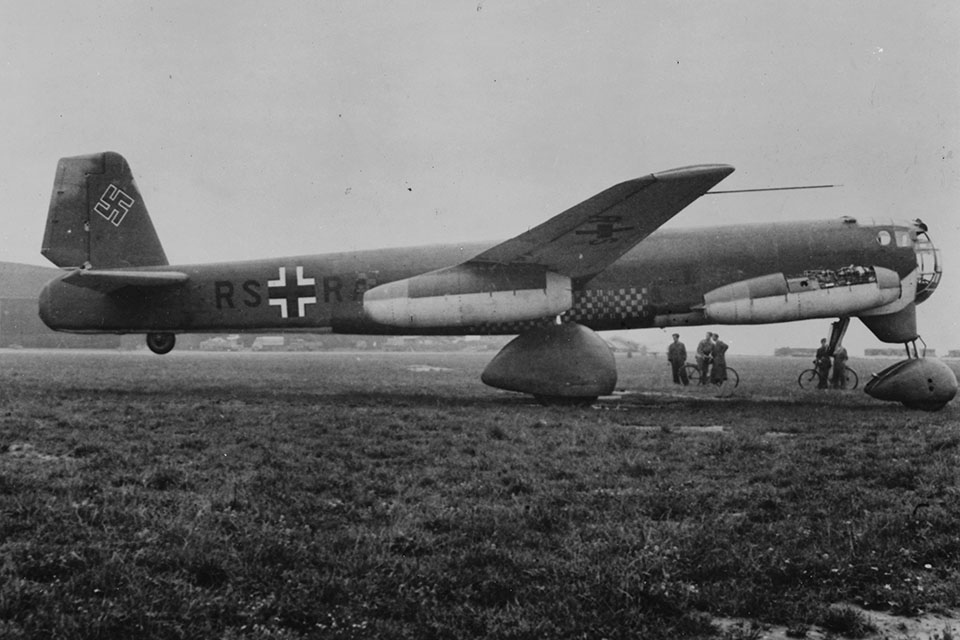
The thin, high-aspect-ratio wing was an all-metal, two-spar structure that incorporated a special Junkers reverse-camber, high-speed airfoil section. To enhance slow-flying capabilities, the wings were fitted with fixed slats at the inboard leading edges to delay root stalling, in conjunction with large slotted trailing edge flaps and ailerons that would droop to 23 degrees, thereby providing camber along the entire span. The test-bed would be powered by four Junkers Jumo 004B-1 axial-flow turbojet engines, each rated at 1,984 pounds of static thrust—the same engines planned for use on Messerschmitt Me-262s—arranged in four individual nacelles, one under each wing at approximately 30 percent span, and one on either side of the forward fuselage.
GET HISTORY’S GREATEST TALES—RIGHT IN YOUR INBOX
Subscribe to our HistoryNet Now! newsletter for the best of the past, delivered every Monday and Thursday.
Ugly duckling
The final sum of all those components, designated the Ju-287V1, was undeniably one of the oddest-looking aerial contrivances of the World War II era. Complete dimensions were a wingspan of 65 feet 113⁄4 inches, a length of 60 feet and a total wing area of 656.6 square feet. At a maximum takeoff weight of 44,092 pounds, wing loading came to 67.2 pounds per square foot, virtually the same as for the contemporaneous Me-262. In the summer of 1944, the Ju-287V1 was transported from Dessau to Brandis Field, near Leipzig, for flight testing, and on August 22 Flugkapitän Siegfried Holzbauer flew it for the first time. To augment takeoff power during that flight, two Walter 2,645-pound-thrust rocket packs—jettisoned shortly after takeoff—were fitted below the wing nacelles. To reduce landing roll, the test-bed used one of the first examples of a drogue parachute deployed from the tail cone.
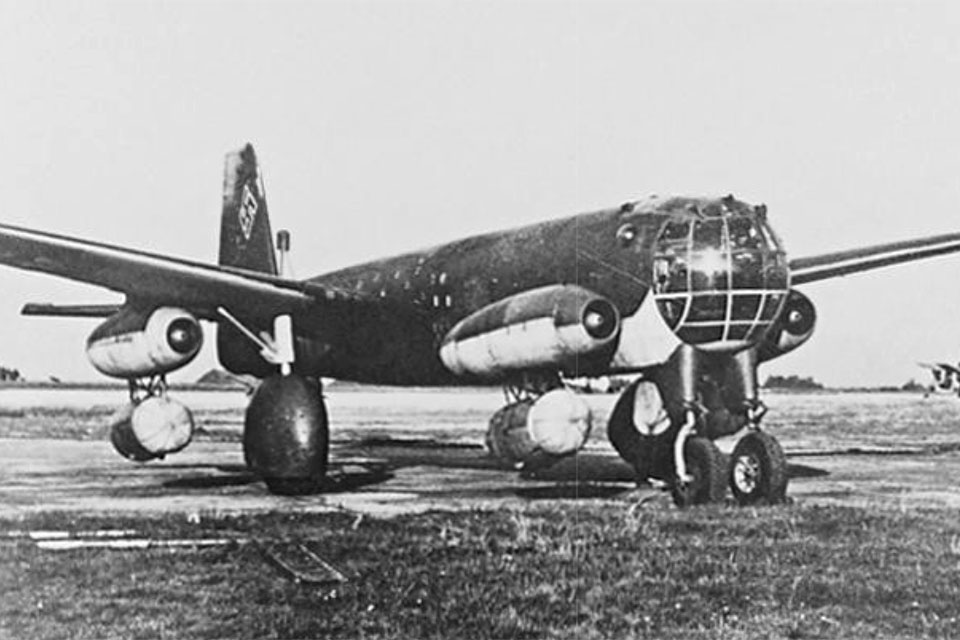
Sixteen more flights were made by the Ju-287V1 from Brandis. Despite its unorthodox planform, the only serious problems encountered during testing—unrelated to aerodynamic configuration—were sporadic flameouts experienced with the temperamental Jumo 004B turbojets and, one time, the explosion of one of the Walter rocket packs. As expected, the Ju-287V1 was exceptionally stable in the slow flight mode, needing hardly any trim changes during flap operation. With flaps extended, the airplane settled on an approach speed of 150 mph and touched down at 118 mph, not excessively high by contemporary standards. During testing, the upper surface of the wings was covered with wool tufts so that the pattern of airflow could be filmed by a camera mounted just forward of the vertical fin. This exercise confirmed Wocke’s predictions on the effects of forward sweep: At low airspeeds, airflow breakaway spread progressively from the root outward to the tip, with a nose-down pitching moment encountered only after the breakaway reached the ailerons.
During testing at higher speeds, the Ju-287V1 was nosed over at full power to reach an airspeed of 404 mph, at which point the aeroelastic limitations of the wing’s design began to show themselves. The chief negative consequence was a reduction in elevator control during maneuvering, but even with that, longitudinal stability was not seriously affected. The maximum level speed attained was 347 mph at 19,685 feet. The Ju-287V1 was thereafter transferred to the Luftwaffe evaluation center at Rechlin, where it was damaged during an Allied bombing raid and could no longer be flown.
Junkers meanwhile went to work on the construction of the Ju-287V2, intended as a follow-on test-bed to evaluate the high-speed characteristics of the planform. The wing remained essentially unchanged from that of the V1, but a fuselage based upon the Ju-388 (a progressive development of the Ju-88 design) was used, incorporating a fully retractable tricycle landing gear. Power would be derived from four experimental Heinkel-Hirth 011A turbojets, each with an expected output of 2,866 pounds of thrust, which were to be slung in paired nacelles under the wings. At the same time, Junkers proceeded with design of the Ju-287V3, which was to be the definitive bomber prototype. Delays in power plant development led Junkers to switch to less powerful but readily available BMW 003A-1 turbojets, rated at 1,760 pounds of thrust each. Six of these engines, pod-mounted in threes, would be located under the wings.
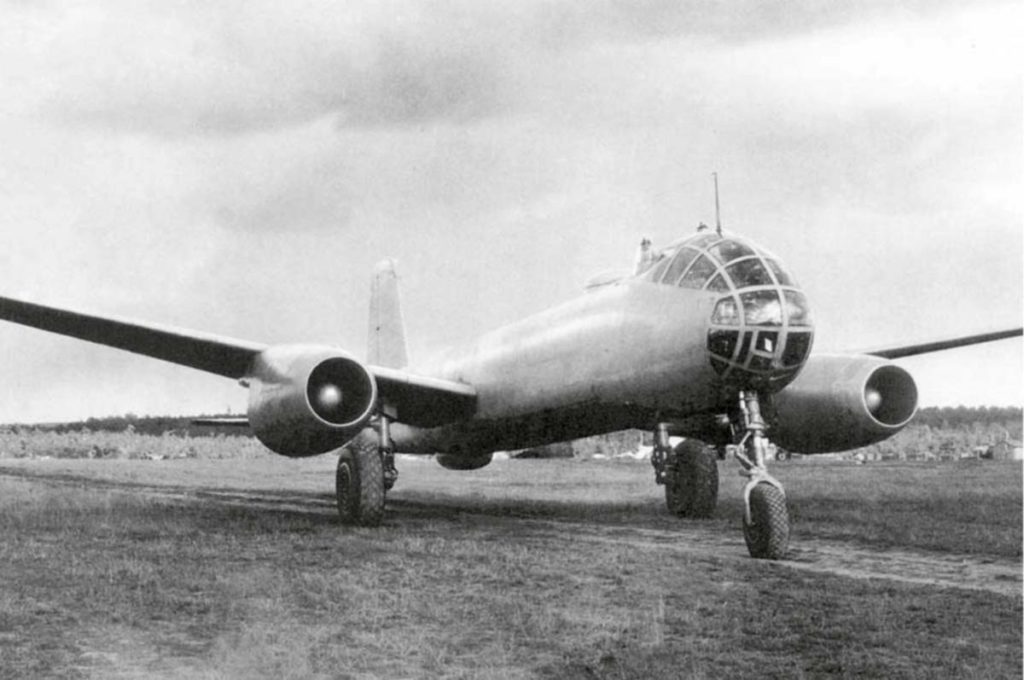
too late to count
Final assembly of the Ju-287V2 was underway when the Dessau plant was overrun by Soviet forces in the late spring of 1945. Not too surprisingly, the captured prototype, along with its tools, jigs, parts and design team, including Wocke himself, were subsequently conveyed to the Soviet Union. The Ju-287V2 was reportedly completed and flown in 1947 at Podberezhye, south of Leningrad, but performance details are not known. Initial component construction had also commenced on the Ju-287V3, which included full operational equipment and armament, but the Soviets did not pursue the project beyond completion of the V2. The manufacturer’s performance estimates for the Ju-287V3 included a top speed of 537 mph at 16,400 feet, with the ability to cruise at 493 mph at 23,000 feet (80 percent power), and a range of 985 miles with an 8,800 pound bombload or 1,325 miles with 4,400 pounds. Had the Soviets not intervened, the Ju-287V2 would have flown in 1945—a remarkable achievement considering that the first postwar Allied jet-propelled medium bomber did not fly for another two years (the North American XB-45, which had its initial flight on March 17, 1947).
When World War II ended, much of Germany’s research and test data on transonic flight caused some American airframe contractors to modify existing proposals for new jet aircraft. One of the most unorthodox proposals generated by the captured German research was Convair’s XB-53 tactical bomber—a tailless, tri-jet design incorporating 30 degrees of forward wing sweep—but the project was canceled in 1948.
The forward-sweep planform lay dormant until 1964, when Hamburger Flugzeubau of West Germany introduced its HFB-320 Hansa Jet, a twin-engine executive transport that could accommodate up to 12 passengers. The Grumman X-29A, which first flew in 1984, combined forward sweep with canards and solved the aeroelasticity problem with wings from very rigid composite materials. After thorough testing, the two X-29s were retired in 1994.
In 1999 the Russian-designed Sukhoi Su-47 (S-37) Berkut (“Golden Eagle”) fighter made its first flight. The Russian government has made funds available for the testing of this latest forward-sweep design, but no plans for production have been announced at the time of this writing.
This article originally appeared in the September 2004 issue of Aviation History. Don’t miss an issue, subscribe!
historynet magazines
Our 9 best-selling history titles feature in-depth storytelling and iconic imagery to engage and inform on the people, the wars, and the events that shaped America and the world.


